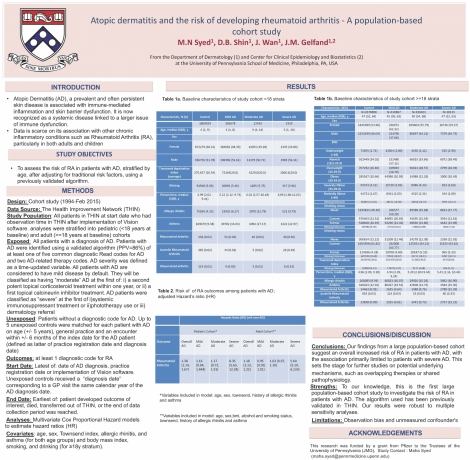Maha Syed
Atopic dermatitis and the risk of developing rheumatoid arthritis - A population-based cohort study
Abstract
Atopic Dermatitis (AD), a prevalent skin disease, is associated with immune-mediated inflammation.Data is scarce on its association with other chronic inflammatory conditions such as rheumatoid arthritis (RA), particularly in both adults and children. We aimed to assess the risk of RA in patients with AD, stratified by age, after adjusting for traditional risk factors, using a previously validated algorithm. A population-based cohort study was performed using a UK based EMR database generalizable to the general population [The Health Improvement Network (THIN)].A total of 625,083 adult patients with AD and 409,431 pediatric AD patients were matched on age, practice, and index date to 2,678,888 adult and 1,809,029 pediatric unexposed controls. Hazard ratios (HRs) were calculated using Cox regression models. We observed an increased risk of incident RA in AD patients (<18y HR:1.38; 95% CI 1.14 -1.67); (≥18y HR: 1.18, 95% CI 1.13-1.22). Further stratifying by the severity of AD,the risk of developing RA was higher in adults and children with severe AD compared to controls (HR: 5.64; 95% CI 5.189-6.13) and (HR: 8.35; 95% CI 5.63-12.38) respectively. Effects were attenuated in both pediatric and adults patients with mild (<18 y HR :1.16 ; 95% CI 0.94-1.44) (≥18y HR 0.95; 95% CI 0.90-1.01) and moderate AD (<18y HR 1.17; 95% CI 0.72-1.91) (≥18y HR 1.03; 95% CI 0.97- 1.10). Our findings suggest an overall increased risk of RA in patients with AD, with the association limited to patients with severe AD. This sets the stage for further studies on potential underlying mechanisms
Keywords
Patient centered outcome research, epidemiology, immune mediated disease, co-morbiditiesCommenting is now closed.
About Us
To understand health and disease today, we need new thinking and novel science —the kind we create when multiple disciplines work together from the ground up. That is why this department has put forward a bold vision in population-health science: a single academic home for biostatistics, epidemiology and informatics.
© 2023 Trustees of the University of Pennsylvania. All rights reserved.. | Disclaimer




Comments
Thank you for your interest in our study. Unfortunately we do not have that data. Patients were assigned a diagnosis date when they received the AD diagnosis by their provider using our validated algorithm. Visits were with either the GP ( primary care provider) or dermatologist. I will definitely take note of this for future studies.